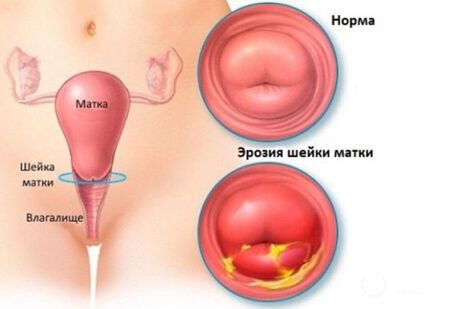- Video: Understanding Cervical Ectropion / Cervical Erosion
- Types of erosion
- Video: My experience with Cervical Ectropion | Let’s chat smear tests, biopsies & cervical erosion!
- Examination of a woman
- Video: CERVICAL EROSION / CERVICAL ECTROPION/ ANM/ GNM/ ALL NURSING EXAMS
- Biopsy
- Colposcopy
- Video: CERVICAL EROSION | Gynaecology and Homoeopathy- 1
- Symptoms of erosion and preparation for treatment
- Video: CERVICAL EROSION [ECTROPIAN]
- Cervical erosion treatment
- Disease prevention
- Video: Cervical Ectropion # Deepak PD. Singh
- Folk remedies for the treatment of cervical erosion
- Video: CERVICAL EROSION/CERVICAL ECTOPY-GYNECOLOGY||EXPLAINED WITH TEXTBOOK OF DR.D.C. DUTTA
- Rate the author (1)
- Comments (1)
Cervical erosion is a condition in which the tissue covering the cervix becomes thinner and less resistant to tearing. This can lead to bleeding after intercourse or during menstruation, as well as discomfort during sex. If you have cervical erosion, you should see a gynecologist for diagnosis and treatment.
Cervical erosion treatment may include the use of topical preparations such as creams or suppositories to help heal the damaged tissue. In some cases, cryodestruction or surgical removal of damaged tissue may be required.

In addition, there are several ways that can help prevent cervical erosion or its recurrence:
- Avoid sex during your period or after childbirth.
- Use condoms to protect against infections that can cause cervical erosion.
- Maintain a healthy lifestyle, including a healthy diet, regular physical activity, and not smoking.
- Regularly visit your gynecologist for preventive examinations and cancer screenings.
So, how to get rid of cervical erosion - further in our article.
Video: Understanding Cervical Ectropion / Cervical Erosion

Types of erosion
Acquired cervical erosion occurs after the onset of a woman's sexual life and can be caused by various factors such as infections, trauma, hormonal changes, childbirth, and the use of spiral contraceptives. This condition can lead to bleeding and pain during intercourse.
Congenital cervical erosion, on the other hand, is present in women from birth and may be related to genetic factors. This condition can also lead to bleeding and discomfort during intercourse.
Depending on the type of erosion, your doctor may recommend a variety of treatments, including topical medications, cryotherapy, or surgical removal.
You may be interested in information about how to treat inflammation of the uterine appendages - read our other article.
Video: My experience with Cervical Ectropion | Let’s chat smear tests, biopsies & cervical erosion!

Examination of a woman
When examining a woman with suspected cervical erosion, the doctor may perform a colposcopy. A colposcopy is a procedure in which the doctor uses a special instrument called a colposcope to look at the cervix and vagina in more detail.
During a colposcopy, the doctor may apply a solution of acetic acid to the cervix to improve the visibility of abnormalities. If the doctor detects cervical erosion, he may take a tissue sample for a biopsy to rule out the presence of malignant cells.
The doctor may also do a cervical cytology test, called a Pap test, to look for changes in the cells of the cervix that may be associated with various diseases, including cervical cancer.
In general, if you suspect cervical erosion, you should see a gynecologist for diagnosis and treatment. The doctor will conduct the necessary studies and prescribe treatment depending on the type and severity of erosion.
You might be interested in information on the topic female gynecological diseases - read our other article.
Video: CERVICAL EROSION / CERVICAL ECTROPION/ ANM/ GNM/ ALL NURSING EXAMS

Biopsy
Examination of a woman with suspected cervical erosion may include several stages.
- First, the doctor performs a visual examination of the cervix using a special tool called a spatula. This allows the doctor to view the size, shape and color of the cervix, as well as to detect the presence of abnormalities such as erosion.
- Secondly, if cervical erosion is suspected, the doctor may perform a colposcopy. A colposcopy is a procedure in which a doctor uses a special instrument called a colposcope to look at the cervix and vagina in more detail. During a colposcopy, the doctor may apply a solution of acetic acid to the cervix to improve the visibility of abnormalities.
- Third, to diagnose cervical erosion, the doctor may take a tissue sample for a biopsy. A biopsy is a procedure in which a doctor removes a small sample of tissue from the cervix for further examination. This can help the doctor determine if the erosion is benign or malignant.
- Fourth, a doctor may do a cervical cytology test, called a Pap test, to check for changes in the cells of the cervix that may be associated with various diseases, including cervical cancer.
In general, the examination of a woman with suspected cervical erosion involves several steps, including visual examination, colposcopy, biopsy, and cytology. This allows the doctor to more accurately diagnose cervical erosion and determine the necessary treatment.
Colposcopy
Colposcopy is a procedure in which a gynecologist uses a special instrument called a colposcope to examine the cervix and vagina in more detail. Colposcopy can be used to diagnose various conditions, including cervical erosion.
When performing a colposcopy, the gynecologist uses a colposcope, which is a magnifying device with bright light, so that he can see the cervical and vaginal areas more clearly. During the procedure, the gynecologist may take tissue samples for biopsy, if necessary.
A colposcopy can help the gynecologist see details of the erosion, such as its size, shape, color, and texture. This allows you to more accurately determine the nature of erosion and decide whether additional analysis or treatment is needed. Colposcopy can also help identify other changes such as polyps, tumors, or infections.
Video: CERVICAL EROSION | Gynaecology and Homoeopathy- 1

Symptoms of erosion and preparation for treatment
The symptoms of cervical erosion may vary, but in most cases it does not cause any symptoms and is discovered by chance during an examination by a gynecologist. However, in some cases, women may experience the following symptoms:
- Profuse vaginal discharge, which may be bloody or purulent.
- Pain during intercourse, especially after a long period of inactivity.
- Unusual discharge after intercourse or exercise.
Preparation for the treatment of cervical erosion depends on which treatment method has been chosen. In most cases, if erosion causes no symptoms and does not pose a health threat, treatment may not be required. However, if a woman has complaints, then treatment may include the following methods:
- Drugs to treat inflammation or infection.
- Cryosurgery, in which cervical tissue is frozen to destroy damaged cells.
- Coagulation, in which damaged cervical tissue is removed using high-frequency electric current.
- Laser therapy, in which damaged cervical tissue is removed using a laser beam.
Before starting treatment, the gynecologist conducts an examination and finds out if the woman has any contraindications to this or that method of treatment. Preparing for treatment may include following certain guidelines, such as avoiding sexual activity for a few days after the procedure, or taking medication to prevent infections.
Video: CERVICAL EROSION [ECTROPIAN]

Cervical erosion treatment
The treatment of cervical erosion depends on the characteristics of the erosion, the presence of symptoms, and the presence of other diseases. In some cases, erosion may not require treatment, especially if it does not cause symptoms and does not progress.
However, if the gynecologist decides that treatment is necessary, then the method of treatment will depend on the characteristics of the erosion. Here are some of the treatments that can be used:
- Drugs: If the erosion is caused by an infection, the gynecologist may prescribe medications such as antibiotics, antivirals, or antifungals that can help clear the infection and resolve the erosion.
- Cryosurgery: is a treatment method in which damaged tissue is frozen and then destroyed. The gynecologist uses a cryoapplicator that releases liquid nitrogen to freeze damaged tissue. This method can be effective for treating erosion that does not bleed or is not deep.
- Coagulation: is a treatment that removes damaged tissue from the cervix using high-frequency electrical current. The gynecologist uses an electrocautery to remove damaged tissue. This method can be effective for treating erosion that causes bleeding.
- Laser therapy: is a treatment method in which damaged tissue is removed using a laser beam. This method can be effective for treating erosion that is deep or that results in bleeding.
After the treatment procedure, the gynecologist may prescribe some recommendations for caring for the cervix. This may include taking medication, limiting sexual activity, using pads, and avoiding baths and pools for a few days after the procedure.
Disease prevention
Prevention of cervical erosion may include several activities. Here are some of them:
- Regular visits to the gynecologist. It is recommended to visit the gynecologist at least once a year for preventive examinations.
- Compliance with the rules of hygiene. It is recommended to use hygiene products that do not violate the acid-base balance of the vagina.
- Using condoms. Using condoms can reduce your risk of contracting an infection that can lead to cervical erosion.
- Healthy lifestyle. It is important to take care of your health and lead a healthy lifestyle, including proper nutrition, regular exercise and avoiding bad habits.
- Hormonal contraceptives. The use of hormonal contraceptives may reduce the risk of cervical erosion.
- Regular screening for cervical cancer. Regular screening for cervical cancer can help detect changes in the tissues of the cervix, including erosion, at an early stage.
- Correct sexual activity. It is important to avoid frequent partner changes, use condoms, and avoid aggressive sex that can damage cervical tissue.
In any case, if you suspect the development of cervical erosion, it is important to contact a gynecologist for diagnosis and treatment.
Video: Cervical Ectropion # Deepak PD. Singh

Folk remedies for the treatment of cervical erosion
While there are many folk remedies that claim to be effective for treating cervical erosion, it is important to remember that many of them have no scientific basis and can be hazardous to health. Therefore, it is important to contact a gynecologist to assess the condition and select the optimal treatment method.
Some folk remedies that are sometimes used to treat cervical erosion include:
- Medicinal herbs. Some herbs, such as calendula, aloe, and chamomile, can be used to make decoctions or infusions, which can then be used to wash the vagina. However, the use of herbs can cause allergic reactions or irritation, so a gynecologist should be consulted before use.
- Bee honey Some people claim that honey can help treat cervical erosion. However, honey may contain bacteria that can cause infection, so its use is not recommended.
- Sea buckthorn oil. Sea buckthorn oil is sometimes used to treat cervical erosion. However, it must be remembered that sea buckthorn oil can cause irritation of the vagina, so its use is not recommended without consulting a gynecologist.
In general, for the treatment of cervical erosion, it is recommended to use methods that have a scientific basis, such as drug therapy, cryosurgery, coagulation or laser therapy. In any case, before using any folk remedies, you should consult a gynecologist.
Video: CERVICAL EROSION/CERVICAL ECTOPY-GYNECOLOGY||EXPLAINED WITH TEXTBOOK OF DR.D.C. DUTTA



















Comments (1)